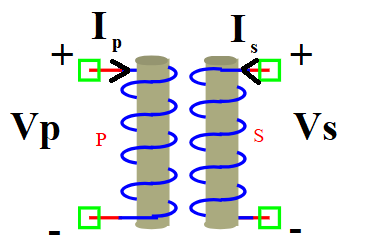Transformer
Symbol
Information

A transformer is a passive electrical device that transfers electrical energy between circuits through mutual inductance. It consists of a primary coil and a secondary coil with inductance values Lp and Ls, respectively. The mutual inductance (M) couples the two windings.
The relationship between voltage (V) and current (I) in a transformer follows these equations:
Where:
\(V_p\), \(V_s\): Primary and secondary voltage (Volts)
\(I_p\), \(I_s\): Primary and secondary current (Amperes)
\(L_p\), \(L_s\): Primary and secondary inductance (Henries)
\(M\): Mutual inductance (Henries)
Transformers are widely used for voltage conversion, isolation, and impedance matching in electrical circuits.
Ports
p1, n1: Primary coil terminals
p2, n2: Secondary coil terminals
Symbol description
Field |
Value |
|---|---|
Symbol.name |
Transformer |
Symbol.file |
Transformer.sym |
Symbol.directory |
Basic |
Symbol.referance |
|
Model.name |
|
Model.file |
Transformer.py |
Model
The Transformer model implements a mutual inductor with primary and secondary windings.
The current and voltage relationships are defined based on mutual inductance and time-dependent behavior of inductors.
Attributes:
Vp (signal): Primary voltage, defined between nodes (p1, n1).
Ip (signal): Primary current, defined between nodes (p1, n1).
Vs (signal): Secondary voltage, defined between nodes (p2, n2).
Is (signal): Secondary current, defined between nodes (p2, n2).
Lp (param): Primary inductance in Henrys (H), default is 1.0 H.
Ls (param): Secondary inductance in Henrys (H), default is 1.0 H.
M (param): Mutual inductance in Henrys (H), default is 0.5 H.
Methods:
analog(): Defines the mutual inductance relationship:
from pyams.lib import model, signal, param
from pyams.lib import voltage, current
from pyams.lib import ddt
class Transformer(model):
"""
Transformer Model (Mutual Inductor)
Defines the relationship: Vp = Lp * dIp/dt + M * dIs/dt
Vs = Ls * dIs/dt + M * dIp/dt
"""
def __init__(self, p1, n1, p2, n2):
# Signal declaration
self.Vp = signal('out', voltage, p1, n1)
self.Ip = signal('in', current, p1, n1)
self.Vs = signal('out', voltage, p2, n2)
self.Is = signal('in', current, p2, n2)
# Parameter declaration
self.Lp = param(1.0, 'H', 'Primary inductance value')
self.Ls = param(1.0, 'H', 'Secondary inductance value')
self.M = param(0.5, 'H', 'Mutual inductance value')
def analog(self):
"""Defines the voltage-current equations for a mutual inductor."""
self.Vp += self.Lp * ddt(self.Ip) + self.M * ddt(self.Is) # Primary winding equation
self.Vs += self.Ls * ddt(self.Is) + self.M * ddt(self.Ip) # Secondary winding equation
Command syntax
The syntax for defining a Transformer in a PyAMS simulation:
# Import the model
from pyams.models import Transformer
# Tname: is the name of the Transformer instance
# p1, n1: Primary winding connections
# p2, n2: Secondary winding connections
Tname = Transformer(p1, n1, p2, n2)